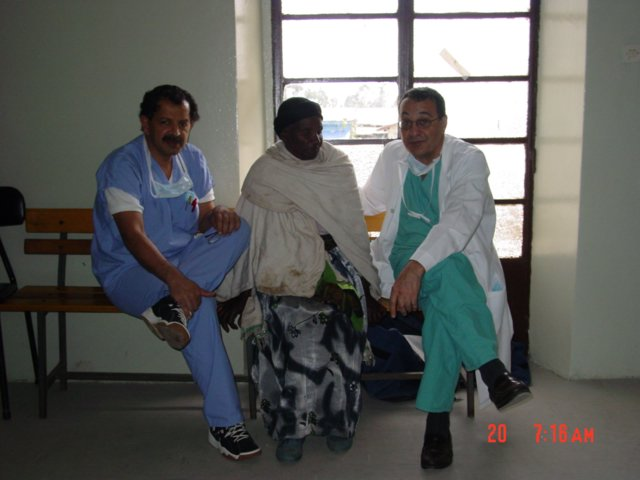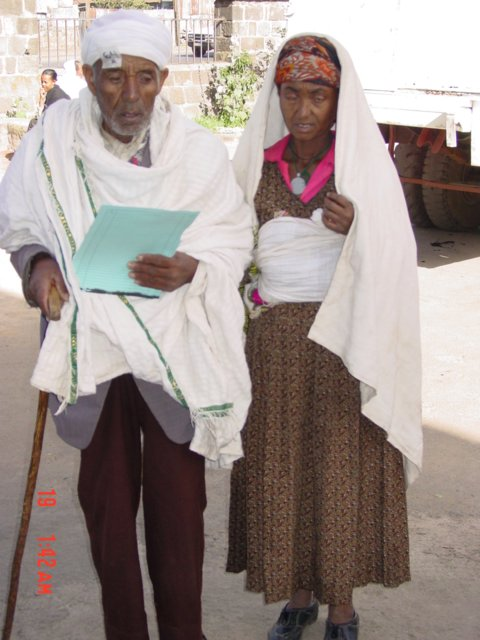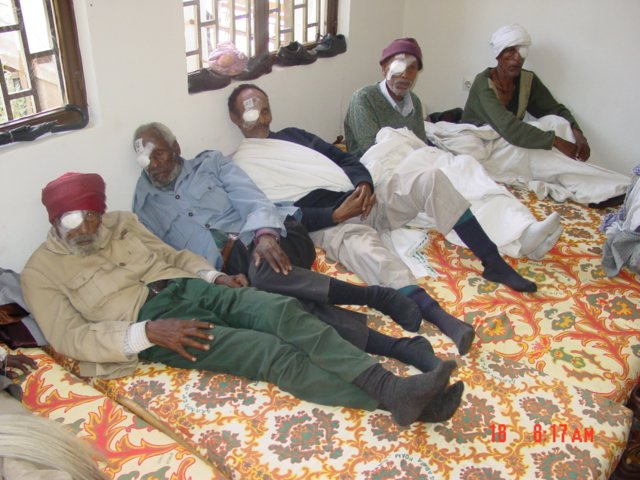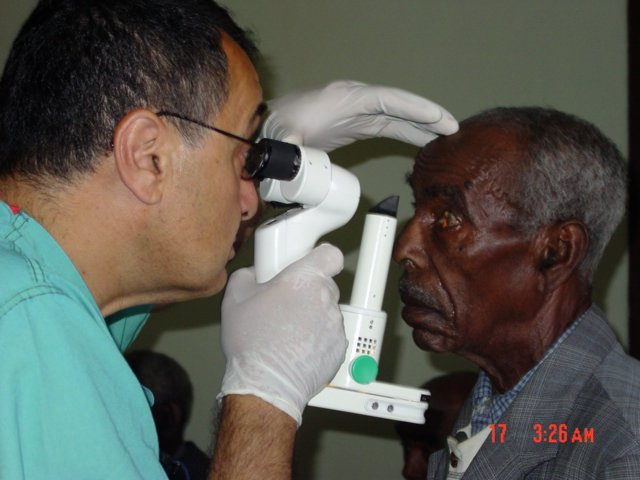
An Overwhelming Need, A Small First Step By Dr. Albert A. Alley
Our most recent eye mission—to Ethiopia May 11-22—could not have happened if not for the prodding and inspiration of Getachew Hirpo, a native of that country who became an American citizen two decades ago. As a resident of Lititz, Pennsylvania, and member of the Lancaster, Pennsylvania, Sunrise Rotary Club, Hirpo was familiar with the work of World Blindness Outreach. He approached me a few years ago to ask if an eye mission could be organized to his homeland. Hirpo served as our contact person with the Ethiopian authorities and medical personnel before the mission and as our guide and translator while it was under way. The assistance of the Rotary Club in the Ethiopian capital of Addis Ababa and a matching grant from the Rotary Foundation also helped to make the mission possible. For Hirpo, the visit to Ethiopia served as a deeply desired opportunity to see his mother and several siblings, all living in Addis Ababa. He hadn’t visited his homeland since 1996. But Hirpo said seeing his family was “secondary,” compared with the mission. “I was very happy to see how it succeeded,” he said. “Our local contacts came through in every way. It was heartwarming to see the people we operated on say they could see for the first time.” At the same time, Hirpo was saddened—as we all were—by the overwhelming need for cataract surgery and other eye treatments among the Ethiopians. Hundreds of prospective patients lined up outside the Das Resta Hospital in Addis Ababa, where we operated. Some, unfortunately, had visual impairments too far gone to be operable. Ethiopia is a country with a high incidence of blindness, 10 times that of the United States. Cataracts account for 50 percent of the cases, but trachoma and vitamin A deficiency also contribute. We focused on cataracts, performing 150 surgeries during the week-long mission. The general living conditions of the Ethiopian people are challenging. There is widespread poverty, overcrowding, lack of sanitation and malnutrition, as well as inadequate medical care. Some areas have no electricity, and residents live in huts or shacks. Moreover, the country has experienced a great deal of political turmoil. More than 900,000 of Ethiopia’s 65 million people are blind and an additional three to four million people are at risk of losing their sight. Eighty percent of the blind could have been spared if they had had access to treatment. Unfortunately, the ratio of ophthalmologists to population is less than one per million. Expressions of gratitude and cries for help did not cease after the members of our team returned home. “After the mission was officially over, I stayed beyond to visit my family,” Hirpo reported. “Hundreds of people lined up outside my parents’ home in Addis Ababa asking for operations. Family members of those the physicians had operated on thanked us.” Our mission in Ethiopia, as in other countries, focused on leaving behind equipment and expertise so local physicians could continue the work we began. My nephew, another Dr. Albert Alley, a family practice physician in Berwick, Pennsylvania, and veteran of some 10 World Blindness Outreach missions, joined us in Ethiopia. He was responsible for doing the A-scans and kerometer readings of the individuals awaiting surgery. “By measuring patients, the Ethiopian physicians we worked with are able to place the correct lenses in during cataract surgery even after we left,” he said. “We are trying to arrange to get measuring devices shipped to them.” As always, we aimed to establish ongoing relationships with the ophthalmologists and other health professionals in our host country. The medical exchange between our team and that of the Ethiopian physicians, under the direction of Dr. Abiye Mulugeta, was very gratifying. We operated side by side, and in fact, the very talented Ethiopian team performed more surgeries than we did. We were privileged in one particular way to be able to add to the knowledge base of the local physicians. They had expressed an interest in sutureless extracapsular surgery, a low-tech, inexpensive method of removing cataracts through a small incision that requires no stitches and therefore less follow-up care than traditional cataract surgery. To help the Ethiopian ophthalmologists learn the procedure, we brought in an eye doctor we had worked with in Kenya in 2003. Dr. Fayaz Kahn, director of the Lions Eye Sight Hospital in Nairobi, Kenya, is an excellent physician with an expertise in sutureless extracapsular surgery. Both we and the Ethiopian doctors were thrilled and excited to have him join us. In terms of equipment, we were able to leave behind a new microscope, a set of surgical instruments and other supplies so the Ethiopian doctors could continue to perform surgeries more effectively and in greater numbers after we left. “With the equipment and knowledge, they can do double the number of cataract surgeries they have in the past,” my nephew, Albert, said. We've also communicated with the Ethiopian doctors on an ongoing basis since the mission, and hope to return to the country in the future, possibly in two years. Hirpo has offered his assistance again to our organization and to any charitable or medical group that would like to provide humanitarian and medical service to his native country. “The Ethiopians need help in almost every area of medicine,” Albert pointed out. “We worked together in the best medical center, but it is one of only a few ophthalmologic centers in the country,” Another high point of the eye mission unrelated to our medical contributions was the opportunity to meet the 9-year-old girl I have been sponsoring through an organization named Compassion. Our team visited her village of Zuya, about 80 miles south of Addis Ababa. We were able to see the school she attends and enjoy the hospitality of her family. Members of our team decided right then and there to sponsor four additional children. It was a very moving experience. Other participants in the mission to Ethiopia were: Mary Susan Carlson, ophthalmologist, Arlington, Virginia.; Ruben Landazuri, ophthalmologist, Quito, Ecuador; and Julie Alley, San Diego, California. The Pennsylvania residents included Cindy Poucel, R.N., Lancaster; Rotarian Marlin Hershey, Lititz; and Thomas Ellinger, Mt. Joy, coordinator. World Blindness Outreach’s next mission is to Ecuador. It will take place Aug. 7-14, and is our fifth to that country.  Dr. Fayaz Kahn from Narobi, Kenya with Dr. Albert A. Alley from Lebanon, PA discussing care with post-op patient.
 Patient and wife arriving at clinic for surgery.
 Post-op patients lying on mats in holding area.
 Dr. Alley performing post-op slit lamp study on post-op patient.
Dr. Albert A. Alley, a diplomate of the American Board of Ophthalmology, practices in Lebanon, Pennsylvania, and is a clinical assistant professor of ophthalmology at Penn State University’s College of Medicine at the Hershey Medical Center. He is co-founder and president of World Blindness Outreach, Inc., a humanitarian organization that supports eye missions to treat correctable blindness and preventable eye diseases among indigent peoples throughout the world. You can contact Dr. Alley at World Blindness Outreach, Inc., 1510 Cornwall Road, Lebanon, PA 17042 or at (717) 273-0662. Send e-mail to wbo@nbn.net. Visit the World Blindness Outreach web site at www.worldblindnessoutreach.com.
|




